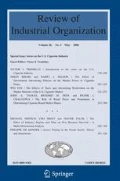Abstract
This research examines the effects of input price discrimination on allocation efficiency and social welfare. Instead of assuming constant marginal costs, we allow downstream firms to produce under increasing marginal costs. When downstream firms operate in separate markets, even though total output remains unchanged, consumer surplus and social welfare could be greater under discriminatory pricing than under uniform pricing. Moreover, the social desirability of input price discrimination can still hold true when downstream firms compete either in Cournot or Bertrand fashion.
Similar content being viewed by others
Notes
Diminishing-marginal-return technologies are a common feature of firms’ production processes (e.g. Varian, 1992). Empirical studies also show that decreasing-returns-to-scale production technology prevails in many industries. Bardhan (1973) shows in India firm-level data that the production of rice exhibits decreasing returns to scale. The same result is found by Basu and Fernald (1997), who use aggregate data to estimate production of 34 manufacturing industries in the U.S.
The change in total output is also critical to the welfare effects of input price discrimination. Yoshida (2000) further shows that input price discrimination—when yielding higher outputs—will harm social welfare. DeGraba (1990) considers cost-reducing R&D investments of downstream firms and finds that input price discrimination reduces downstream investments and thus market output, and thereby reduces social welfare.
We restrict our attention on linear pricing, rather than non-linear pricing, which has also been examined in the literature; e.g., Herweg and Müller (2014). In the model with separate markets, if the input monopolist charges two-part tariffs, then it will set the per-unit prices at zero in order to eliminate double marginalization; this allows it to extract all of the possible downstream rents via fixed payments. As a result, both discriminatory pricing and uniform pricing lead to the same equilibrium prices and outputs and of course are indifferent from a welfare point of view.
With separated markets, the condition \(\alpha_{1} { < }\tfrac{{({2} + \beta_{1} )(1 + \alpha_{2} ) + 2 + \beta_{2} }}{{6 + 2\beta_{1} + \beta_{2} }}\) is required for this purpose.
The demonstration of the effects on input price elasticity of the two cost parameters under non-linear demands is available upon request to the author.
Firm i’s price elasticity of input demand is \(\varepsilon_{i} = - \tfrac{{\partial q_{i} }}{{\partial w_{i} }}\tfrac{{w_{i} }}{{q_{i} }} = \tfrac{{({2} + \beta_{j} )w_{i} }}{{1 + \alpha_{j} + \beta_{j} + w_{j} - (2 + \beta_{j} )(\alpha_{i} + w_{i} )}}\). Hence, firm i’s input demand is more elastic for larger \(\alpha_{i}\) and is unaffected by the value of \(\beta_{i}\).
For Cournot competition, the demonstration of the cost effects on input price elasticity under non-linear demands is available upon request to the author.
The signs of the two terms are detailed in the Proof of Proposition 2 in the “Appendix”.
When \(\gamma\) rises, the two products become more substitutable. In the extreme, the two goods are homogeneous if \(\gamma = {1}\), whereas they are independent if \(\gamma = {0}\).
References
Arya, A., & Mittendorf, B. (2010). Input price discrimination when buyers operate in multiple markets. Journal of Industrial Economics, 58(4), 846–867.
Bardhan, P. K. (1973). Size, productivity and returns to scale: An analysis of farm level data in Indian agriculture. Journal of Political Economy, 81(6), 1370–1386.
Basu, S., & Fernald, J. G. (1997). Returns to scale in U.S. production: Estimates and implications. Journal of Political Economy, 105(2), 249–283.
Chen, C.-S. (2017). Price discrimination in input markets and quality differentiation. Review of Industrial Organization, 50(3), 367–388.
DeGraba, P. (1990). Input market price discrimination and the choice of technology. American Economic Review, 80(5), 1246–1253.
Dertwinkel-Kalt, M., Haucap, J., & Wey, C. (2016). Procompetitive dual Pricing. European Journal of Law and Economics, 41(3), 537–557.
Herweg, F., & Müller, D. (2012). Price discrimination in input markets: Downstream entry and efficiency. Journal of Economics and Management Strategy, 21(3), 773–799.
Herweg, F., & Müller, D. (2014). Price discrimination in input markets: Quantity discounts and private information. Economic Journal, 124(577), 776–804.
Herweg, F., & Müller, D. (2016). Discriminatory nonlinear pricing, fixed costs, and welfare in intermediate-goods markets. International Journal of Industrial Organization, 46, 107–136.
Inderst, R., & Shaffer, G. (2009). Market power, price discrimination, and allocative efficiency in intermediate-goods markets. RAND Journal of Economics, 40(4), 658–672.
Inderst, R., & Valletti, T. (2009). Price discrimination in input markets. RAND Journal of Economics, 40(1), 1–19.
Kao, K.-F., & Peng, C.-H. (2012). Production efficiency, input price discrimination, and social welfare. Asia-Pacific Journal of Accounting and Economics, 19(2), 227–237.
Katz, M. L. (1987). The welfare effects of third-degree price discrimination in intermediate good markets. American Economic Review, 77(1), 154–167.
Kim, H., & Sim, S. (2015). Price discrimination and sequential contracting in monopolistic input markets. Economics Letters, 128, 39–42.
O’Brien, D. P. (2014). The welfare effects of third-degree price discrimination in intermediate good markets: The case of bargaining. RAND Journal of Economics, 45(1), 92–115.
Schmalensee, R. (1981). Output and welfare implications of monopolistic third-degree price discrimination. American Economic Review, 71(1), 242–247.
Valletti, T. (2003). Input price discrimination with downstream Cournot competitors. International Journal of Industrial Organization, 21, 969–988.
Varian, H. R. (1985). Price discrimination and social welfare. American Economic Review, 75(4), 870–875.
Varian, H. R. (1992). Microeconomic analysis. Norton.
Yoshida, Y. (2000). Third-degree price discrimination in input markets: Output and welfare. American Economic Review, 90(1), 240–246.
Acknowledgements
The author is very thankful to Lawrence J. White (Editor) and two anonymous referees for their insightful comments and suggestions. The financial support from the Ministry of Science and Technology of Taiwan (MOST 106-2410-H-031-009-MY2) is gratefully acknowledged.
Author information
Authors and Affiliations
Corresponding author
Additional information
Publisher's Note
Springer Nature remains neutral with regard to jurisdictional claims in published maps and institutional affiliations.
Appendix
Appendix
1.1 Proof of Lemma 1
From (7) and (8), comparing firms’ outputs under either pricing regime yields:
where \(\Delta \alpha = \alpha_{1} - \alpha_{2} > 0\). If \(\beta_{1} \ge \beta_{2}\), then \(q_{1}^{d} - q_{2}^{d} < 0\) and \(q_{1}^{u} - q_{2}^{u} < 0\). If \(\beta_{1} < \beta_{2}\), then the two output differences could be positive if \(\Delta \alpha\) is sufficiently small. □
1.2 Proof of Proposition 1
By substituting equilibrium outputs (7) and (8) into (10) and (12) under either pricing regime, we specify the comparisons of consumer surplus and social welfare between discriminatory pricing and uniform pricing as:
If \(\beta_{1} \ge \beta_{2}\), then the signs of \(\Delta CS\) and \(\Delta SW\) are negative. If \(\beta_{1} < \beta_{2}\), and \(\Delta \alpha\) is sufficiently small, then the two signs are positive.□
1.3 Proof of Proposition 2
The two terms \(\Delta \alpha + \beta_{1} q_{1}^{d} - \beta_{2} q_{2}^{d}\) and \(\Delta \alpha + \beta_{1} q_{1}^{u} - \beta_{2} q_{2}^{u}\) can be rearranged, respectively, as:
which are positive if \(\beta_{1} \ge \beta_{2}\); they are negative if \(\beta_{1} < \beta_{2}\) and \(\Delta \alpha\) is sufficiently small.
By substituting the above two terms into (18) and rearranging it, we derive the cost difference as:
where \(\psi = 2(2 + \beta_{1} + \beta_{2} )(3 + 2\beta_{1} + 2\beta_{2} + \beta_{1} \beta_{2} ) > 0\), \(\phi = 24 + 21\beta_{1} + 17\beta_{2} + 4\beta_{1}^{2} + 2\beta_{2}^{2} + 10\beta_{1} \beta_{2} + \beta_{1} \beta_{2}^{2} + \beta_{1}^{2} \beta_{2} > 0\), and \(\theta = 2(2 + \beta_{1} + \beta_{1} )(1 - \alpha_{1} )(\beta_{1} - \beta_{2} )\). Note that \(\theta < 0\) if \(\beta_{1} < \beta_{2}\) and otherwise \(\theta \ge 0\). Hence, if \(\beta_{1} < \beta_{2}\), then the sign of \(\Delta TC\) is negative when \(\Delta \alpha\) is sufficiently small. Under such circumstances, discriminatory pricing is cost-reducing and thus more socially desirable than uniform pricing.□
1.4 Results under Bertrand competition
From the first-order conditions for profit maximization, the reaction functions under Bertrand competition are \(p_{i} (p_{j} ) = \frac{{(1 - \gamma )[1 - \gamma^{2} + \beta_{i} + (1 + \gamma )(\alpha_{i} + w_{i} )]}}{{2 - 2\gamma^{2} + \beta_{i} }} + \frac{{\gamma (1 - \gamma^{2} + \beta_{i} )}}{{2 - 2\gamma^{2} + \beta_{i} }}p_{j} ,i \ne j,i,j = 1,2\), whereby the equilibrium prices are derivable as follows:
where \(A = (4 - \gamma^{2} )(1 - \gamma^{2} ) + (2 - \gamma^{2} )(\beta_{1} + \beta_{2} ) + \beta_{1} \beta_{2} > 0\).
The derived demands on input are then given as:
From these demands, the input monopolist chooses input prices for profit maximization. The equilibrium input prices under corresponding pricing regimes are presented in (19), whereby the equilibrium outputs under either pricing regime are then derivable as:
where \(\theta^{\prime} = (2 - \gamma^{2} + \beta_{j} )(6 - 3\gamma^{2} - 2\gamma + 2\beta_{i} + \beta_{j} ) - \gamma^{2} > 0\), and \(\theta^{\prime\prime} = (2 + \gamma - \gamma^{2} + \beta_{i} )(2 + \gamma - \gamma^{2} + \beta_{j} ) - 4\gamma^{2} > 0\).
To simplify notations, we assume hereafter that \(\alpha_{2} = 0\) and \(\beta_{2} = 1\). Substituting the above equilibrium outputs into the cost difference defined in (18) and rearranging yields:
The sign of \(\Delta TC\) depends on the sign of the term \([\Psi \alpha_{1} - \Gamma (1 - \beta_{1} )]\), which is always positive if \(\beta_{1} \ge 1\). Nevertheless, it is ambiguous if \(\beta_{1} < 1\). In this case, when \(\alpha_{1}\) approximates to 0, the term \([\Psi \alpha_{1} - \Gamma (1 - \beta_{1} )]\) becomes negative. Moreover, the value of the term is increasing with \(\alpha_{1}\). As a result, given \(\beta_{1} < 1\), if \(\alpha_{1}\) is sufficiently small, then the term is negative, and thus discriminatory pricing leads to a lower production cost relative to uniform pricing.
With differentiated products, social welfare is defined as \(W \equiv U - TC_{1} - TC_{2}\), whereby the welfare difference, \(\Delta W \equiv W^{d} - W^{u}\), is then derivable as:
The sign of \(\Delta W\) depends on the sign of the term \([ - \Psi^{\prime}\alpha_{1} + \Gamma (1 - \beta_{1} )]\), which is negative if \(\beta_{1} \ge 1\), but is ambiguous if \(\beta_{1} < 1\). If \(\beta_{1} < 1\), then when \(\alpha_{1}\) is close to zero, the sign of \([ - \Psi^{\prime}\alpha_{1} + \Gamma^{\prime}(1 - \beta_{1} )]\) becomes positive. Moreover, the value of \([ - \Psi^{\prime}\alpha_{1} + \Gamma^{\prime}(1 - \beta_{1} )]\) is decreasing with \(\alpha_{1}\). As a result, if \(\beta_{1} < 1\) and \(\alpha_{1}\) is not too large, then the term could be positive, whereby discriminatory pricing is more socially desirable than is uniform pricing under Bertrand competition.
Rights and permissions
About this article
Cite this article
Chen, CS. Input Price Discrimination and Allocation Efficiency. Rev Ind Organ 60, 93–107 (2022). https://doi.org/10.1007/s11151-021-09830-1
Accepted:
Published:
Issue Date:
DOI: https://doi.org/10.1007/s11151-021-09830-1




